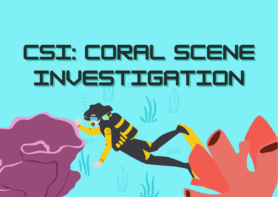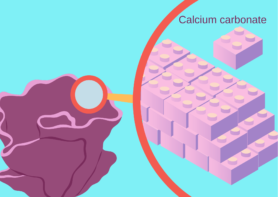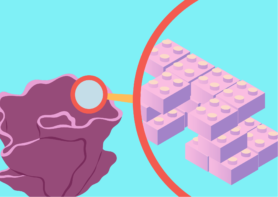Oceanic Acidification
CSI: Coral Scene Investigation
There is something going on under the ocean’s surface. Something is making the reef weaker. What is going on? It is up to the CSI team to find out. With their cutting-edge science, they will get to the bottom of this. Come with them and find out about coral skeletons, sponges and the threats to the coral reef. Put on your scuba gear and join them in the warm waters!
by Anne Smits

The CSI team takes a dive into the water to get a closer look at the coral reef. The reef is made of all sorts of brightly coloured stony corals. Stony corals are corals with a rock-hard skeleton. They build their skeletons by combining the building blocks calcium and carbonate. Lots of other sea creatures do the same thing in order to build strong shells and skeletons. Building a skeleton is really easy for a coral, because the building blocks are all dissolved in the ocean water, where it’s close at hand for the coral to use. But on the Coral Scene something weird has happened. The coral does not look very healthy. When the team tests the waters around the coral reef they find that there are not a lot of carbonate building blocks in the water. Plus, the water is slightly more acidic than it should be.

Corals build their skeleton with building blocks of calcium carbonate
The team wonders why there is so little carbonate in the water. They ask the help of an expert at NIOZ (Netherlands Institute for Sea Research): prof. dr. Gert-Jan Reichart. He tells the CSI team that the acidic water has to do with the well-known greenhouse gas CO2. About a quarter of CO2 emissions are taken up by the ocean. but the gas causes trouble there as well. “CO2 is a molecule that reacts with water,” Gert-Jan explains to the CSI team. He tells that when CO2 dissolves in the ocean water, it forms an acid. This process is called ocean acidification. Ocean acidification messes with the balance in building blocks like carbonate. So, when the ocean is more acidic, there are less carbonate building blocks available for the coral to use to build strong skeletons.
(Want to know more about how CO2 causes ocean acidification? Mieke’s blog is coming soon!)
The CSI team investigates the coral reef to see if the corals’ skeletons are affected by ocean acidification. “You would expect corals to build a smaller skeleton when there are not enough building blocks”, one of the members of the team says. But when she looks close at the coral skeleton it does not seem to be particularly small, but it does feel very weak. To find out what might be happening to the coral, the team tries to reconstruct the process with Lego blocks. First they build a strong tower of a meter high and then they try to build a tower of the same height, but with only half the blocks. When the second tower reaches a meter, it is not as strong. There are gaps where the team had to leave out blocks so that they would have enough to build the whole tower. The team suspects that something similar must be happening to the coral reef. When there are too few building blocks, the coral’s skeleton becomes not as strong as it should be.

When there is not enough calcium carbonate, the coral skeleton becomes weaker
When the CSI team takes a closer look at the coral’s ‘brittle bones’, they spot some corals with strange marks. It is as if something has dug a hole straight through the coral skeleton. The team investigates the holes and inside of them they find… sponges. Further investigation shows that the sponges are excavating sponges. Like miners, these sponges dig themselves into the coral skeleton to hide there. How do these sponges do that? The CSI team wonders.
Again, the team goes to NIOZ for help. At NIOZ, researchers discovered that the sponges are able to dig into coral by using acid to dissolve the coral skeleton. But then, the team finds out something that is even more worrying: the sponges get better at digging into the coral when the ocean becomes more acidic. So while corals to have a harder time building their skeleton because of acidification, the sponges get a boost and damage the coral skeletons even more.
Damaged skeletons are bad news for coral reefs. The CSI team suspects that weaker skeletons are more likely to break when they protect the coast from strong waves or storms. The team is afraid that when stony corals are having a hard time, another type of coral – soft coral – might take over. Soft corals build their skeleton with building blocks of protein instead of calcium carbonate. So unlike the stony corals, soft corals are not that bothered by ocean acidification. A 2020 study has shown that in past times, when the sea was naturally more acidic, reefs of stony corals disappeared and soft corals took their place. If the ocean keeps becoming more acidic, the CSI team might have to switch to only studying soft corals in the future.
(Interested in how ocean acidification worked in the past? Stay tuned for Karel’s blog!)
Luckily, Gert-Jan has some optimistic news for the team. “Coral reefs will probably still survive for a while” he says, but then adds: “until at some point there is too much CO2”. He explains that back when corals evolved, there was more CO2 than there is now. So they are able to handle it. “Only now the increase in CO2 is going too fast”, Gert-Jan warns the team. “If the amount of CO2 gets too high, they might start doing really poorly.”
The Coral Scene Investigators in this story found out that the coral reefs are threatened by ocean acidification. It messes with their building blocks. It helps their enemies. Luckily, there is a real CSI out there: researchers all over the world are investigating the coral reefs to find out what is happening to them and how we can stop it. Check out this interview with a real ‘coral scene investigator’!

